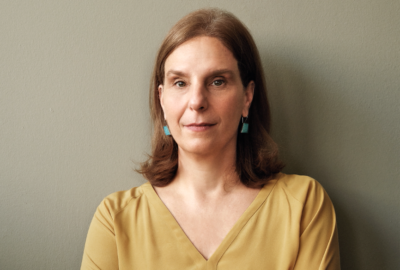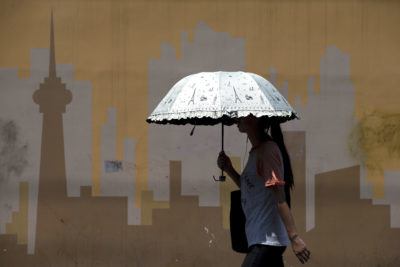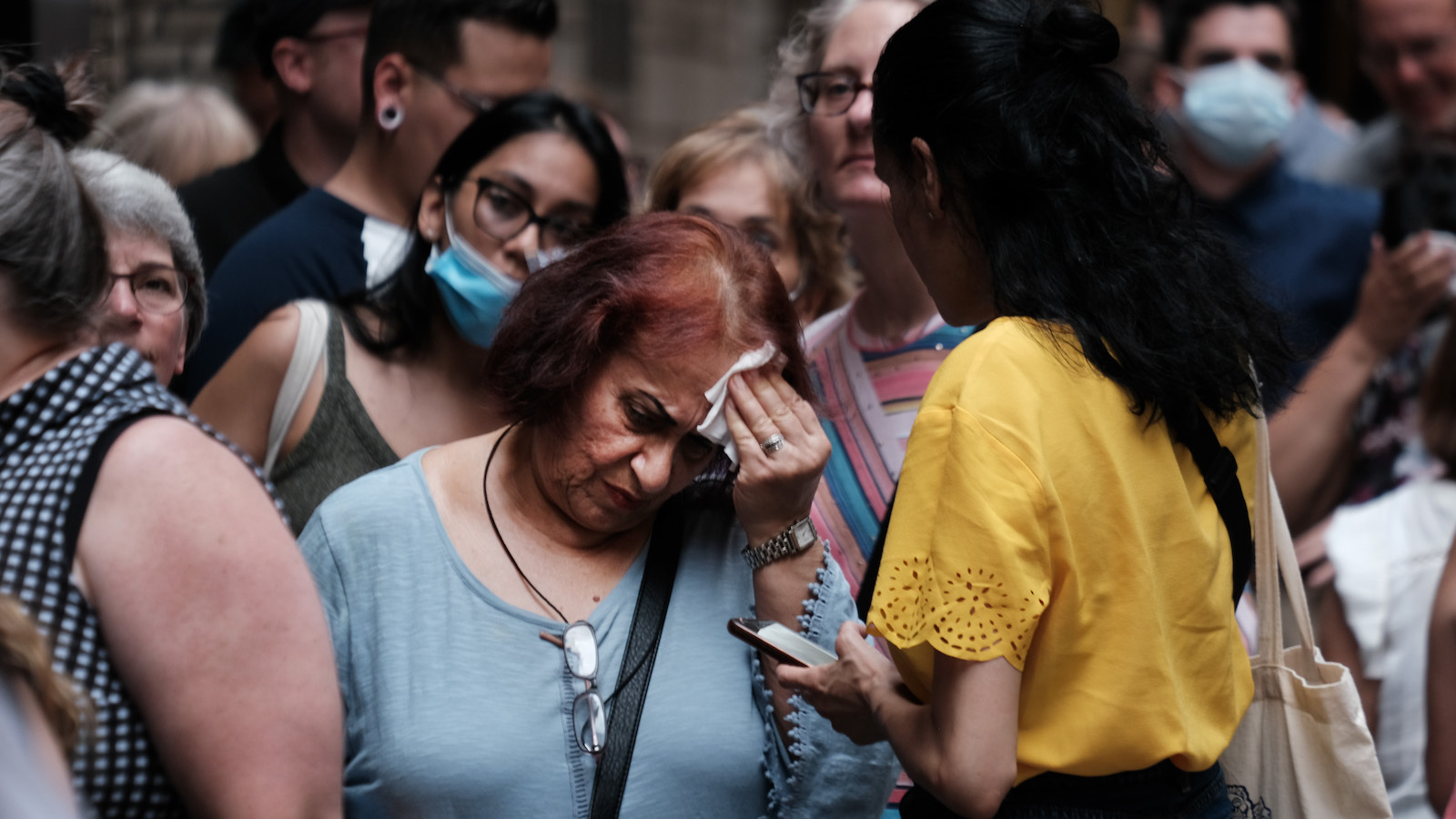In 2022, a 12 months during which 70,000 Europeans died of heat-related causes, the United Nations named Eleni “Lenio” Myrivili the world’s first-ever world chief warmth officer. A former deputy mayor of her hometown of Athens, Greece, Myrivili had overseen a multimillion-dollar price range and a workers of 500 and was largely answerable for establishing that metropolis’s status as a frontrunner in climate-change adaptation.
Now, she is working to increase that imaginative and prescient on a worldwide scale. Her monitor file of constructing change by means of collaborations with nationwide governments, U.N. companies, NGOs, foundations, academia, and the personal sector led the journal Nature to call Myrivili one in every of 10 folks most answerable for shaping science in 2023.
Of explicit concern to Myrivili is the impression that excessive city warmth — the number-one public well being concern cities will face within the coming many years — may have on the world’s most susceptible. In an interview with Yale Atmosphere 360, she burdened the necessity to shield these populations, partially by guaranteeing that extra financing flows of their course. “Cities which have cash can present us the way in which, after which others can see what matches and what doesn’t,” she says. “However we now have to give attention to the poorer cities, that are those that may undergo most.”

Eleni Myrivili
Eleni Myrivili
Yale Atmosphere 360: What does the place of World Chief Warmth Officer entail?
Eleni Myrivili: I’m folding work on warmth resilience into the initiatives that UN-Habitat [the United Nations’ program for human settlements and sustainable urban development] is doing in city facilities. They’ve been engaged on sustainability, accessibility, fairness, and find out how to make cities extra livable, particularly within the World South, however local weather change hasn’t actually been central. My goal is to raise warmth as a difficulty as a result of it impacts lives and livelihoods greater than every other local weather consideration.
e360: Individuals appear to pay attention to the risks of floods and wildfires, however warmth has in some way flown below the radar. Is that altering?
Myrivili: Very a lot so. Final 12 months was the most popular 12 months ever recorded. We had limitless fires and heatwaves. Individuals within the Northern Hemisphere had been swimming in months that they’d by no means gone swimming. We’re all of the sudden changing into rather more aware about warmth and the way it’s linked with occasions like drought, wildfires, flooding, hurricanes, and tornadoes.
“We’ve constructed cities based mostly on the concept that we now have fossil fuels to assist us deal when it will get too sizzling.”
e360: A latest research printed in The Lancet Regional Well being – Europe discovered that in the summertime of 2022, excessive warmth killed 70,000 folks in Europe. Is quantifying the impression of utmost warmth one thing that folks have begun to give attention to extra?
Myrivili: The proliferation of research linked to warmth in the previous couple of years is superb. Research on every part from meteorological impacts to impacts on the physique.
e360: How does excessive warmth have an effect on the physique?
Myrivili: The primary means our physique offers with warmth is thru perspiration. But when there’s loads of humidity within the air, perspiration doesn’t evaporate and funky us down. Our physique goes right into a panic. The cardiovascular system is affected first, because it tries to maneuver blood to the pores and skin and to our muscle mass. However then an entire collection of programs begins to have bother. You may turn into dizzy or confused as a result of not sufficient blood goes to the pinnacle, or you possibly can go into renal failure. For this reason warmth can ship folks with pre-existing well being issues to the hospital actually quick.

A pocket park in Athens.
Athens Municipality
e360: Warmth is a selected drawback in cities, the place two-thirds of the worldwide inhabitants will reside by 2050. Why is it so problematic in city areas? What occurs in a metropolis that doesn’t occur within the countryside?
Myrivili: The issue with cities is that we now have a constructed atmosphere based mostly on concrete, asphalt, glass, and metal. These supplies all take in warmth and radiate it at evening. If evening temperatures don’t fall — within the Northern Hemisphere, at the least — your physique by no means actually recovers from the daytime warmth. It’s the evening temperatures, relatively than the morning temperatures, which can be the damaging time. That’s the reason, after we speak about creating shade in streets or in public areas, we would like shading that’s retractable, so the warmth isn’t trapped within the metropolis at evening.
We’ve additionally constructed cities based mostly on the concept that we now have fossil fuels to assist us deal when it will get too sizzling or too chilly. We forgot that for hundreds of years folks discovered options for excessive environments, and we threw them out the window. We had inside courtyards with water fountains and timber. We had double roofing with air passing by means of and whitewashing, which displays the solar’s rays. This can be a notably vital resolution in poor international locations, the place the roofs are typically concrete or corrugated iron.
e360: What have you ever been doing to chill issues down in Athens?
Myrivili: We’ve been including timber and inexperienced areas, which, in a densely constructed metropolis like Athens might be troublesome. We’ve accomplished pocket parks and created new areas by shifting and demolishing buildings, but additionally by placing inexperienced corridors in current streets and taking away vehicles. Automobiles and air conditioners create extra warmth in public areas. We have to create inexperienced streets, inexperienced corridors for pedestrians, electrical public mobility, scooters, and bicycles. The facilities of the cities of the longer term must be empty of vehicles. In locations like Amsterdam and Paris, they’re already doing this.
“There’s proof that when warmth waves are named, there’s a special sort of mobilization.”
We’re additionally making the most of the engineering feat that could be a 24-kilometer-long underground aqueduct constructed by the Romans in 150 A.D. There’s nonetheless water in there, clear sufficient to make use of for irrigation, so the Athens Water Provide and Sewerage Firm, which owns the aqueduct, is working with the Ministry of Tradition — as a result of it’s a monument — and the eight municipalities below which it runs to supply a strategic plan that may create inexperienced areas supported by the aqueduct that will likely be constructed to particular tips to make sure they cool the town.
e360: If it’s important to knock down buildings and create new roads and new parks, you’re going to want buy-in from many various entities, every with their very own pursuits. How a lot of your work is developing with improvements and dealing with scientists and panorama designers, and the way a lot is simply attempting to get the politics ironed out, to get everyone on board to make what, in lots of circumstances, are very massive adjustments?
Myrivili: For this reason the chief warmth officer position is vital. As a result of it’s important to have any person who’s doing all of the politicking and who’s prepared to knock on doorways and get completely different folks to collaborate. It takes a very long time, and it’s not straightforward. The U.N. is a gigantic administration, so it may be troublesome to navigate.

A lady shields herself from the solar as she passes a mural in Beijing in July 2015.
Andy Wong / AP Picture
e360: You’ve got a grasp’s diploma in efficiency research and a Ph.D. in anthropology. Is that this the place these research are available in?
Myrivili: I wished to be a theater director. I by no means thought I might get pleasure from being an administrative director, however I actually beloved it. Once I was deputy mayor, we had 500 folks within the division, and I loved putting in a crew that labored nicely collectively. Anthropology has to do with with the ability to perceive completely different views and see that communities have completely different wants and references and methods of speaking about issues. Anthropology has helped me to not be a vacationer, to be extra a part of the group wherever I am going.
e360: You’ve talked about naming impending warmth waves, the way in which we do with tropical storms and hurricanes.
Myrivili: There’s proof that when warmth waves are named, there’s a special sort of mobilization. However extra vital than naming is categorization. This may be based mostly on a system on the metropolis degree. You need to have a way of when it turns into actually harmful and dangerous the place you might be.
“In the previous couple of years, the variety of folks shopping for air conditioners has grown exponentially.”
However there are answers that may assist shield probably the most susceptible. Labor ministries can enact legal guidelines that shield laborers, ensuring that folks working below harmful circumstances — notably in lower-paying jobs like building, agriculture, and supply companies — aren’t left to burn below the solar. When can folks work, and below what circumstances? When ought to they not work in any respect? How can we ensure we examine in on folks, particularly older folks residing alone? We are able to create neighborhood networks with volunteer companies and introduce apps that remind family members to examine in on of us.
e360: We all know what a distinction political management could make, for good or unwell. Contemplating all that’s occurring geopolitically, how will we keep hopeful?
Myrivili: I see the personal sector coping with local weather change increasingly severely, as firms notice that their programs are depending on logistics, transportation programs, and pure sources which can be coming below risk.
On the U.N. Local weather Change Convention in Dubai, 63 nationwide governments signed onto one thing known as the World Cooling Pledge, committing to cut back cooling-related emissions whereas growing entry to cooling. That is vital as a result of we now have near 2 billion items of air-con across the globe. In the previous couple of years, the variety of folks shopping for air conditioners has grown exponentially, particularly in international locations with rising center lessons.

A inexperienced area atop a metro station in Singapore.
David Goldman / AP Picture
e360: Singapore appears to be main the way in which in relation to warmth administration.
Myrivili: The town-state has accomplished an incredible job creating fundamental guidelines by means of which we will perceive find out how to create cooler districts, neighborhoods, streets, and buildings, from the massive image to the small. When establishing new neighborhoods, they take into account how excessive the buildings must be, how deep the canyons, find out how to set up the shading that comes from the buildings. And Singapore’s nice as a result of it’s a metropolis and a state, and it has cash.
e360: However what about locations like Dhaka and Lagos?
Myrivili: We have now to mobilize financing and create insurance policies that may assist folks in these cities. That’s why I wished my place to be a part of UN-Habitat, as a result of that’s the place the main focus is.
e360: Are there monetary mechanisms, by means of the World Financial institution or in any other case, particular to warmth in cities?
Myrivili: That is a part of my massive effort throughout the U.N., to create a particular mechanism that may goal monetary assist to cities all over the world for saving folks from dropping their lives or livelihoods to warmth.
We have now to ramp up resilience and adaptation financing as a result of we’ll save lives and ecosystems. Though warmth would be the number-one public well being concern that cities will likely be coping with within the coming many years, it’s nonetheless troublesome to get funding. We’re not prepared for it, simply as we weren’t prepared for Covid. And we now have to prepare.
This interview was edited for size and readability.
